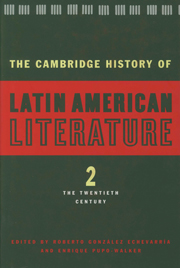Book contents
- Frontmatter
- Introduction to Volume 2
- 1 Modernist poetry
- 2 Modernist prose
- 3 The Vanguardia and its implications
- 4 The literature of Indigenismo
- 5 Afro-Hispanic American literature
- 6 The Criollista novel
- 7 The novel of the Mexican Revolution
- 8 The Spanish American novel from 1950 to 1975
- 9 The Spanish American novel: recent developments, 1975 to 1990
- 10 Spanish American poetry from 1922 to 1975
- 11 The modern essay in Spanish America
- 12 Literary criticism in Spanish America
- 13 The autobiographical narrative
- 14 The twentieth-century short story in Spanish America
- 15 Spanish American theatre in the twentieth century
- 16 Latin American (Hispanic Caribbean) literature written in the United States
- 17 Chicano literature
- Index
- Bibliographies
- References
3 - The Vanguardia and its implications
Published online by Cambridge University Press: 28 March 2008
- Frontmatter
- Introduction to Volume 2
- 1 Modernist poetry
- 2 Modernist prose
- 3 The Vanguardia and its implications
- 4 The literature of Indigenismo
- 5 Afro-Hispanic American literature
- 6 The Criollista novel
- 7 The novel of the Mexican Revolution
- 8 The Spanish American novel from 1950 to 1975
- 9 The Spanish American novel: recent developments, 1975 to 1990
- 10 Spanish American poetry from 1922 to 1975
- 11 The modern essay in Spanish America
- 12 Literary criticism in Spanish America
- 13 The autobiographical narrative
- 14 The twentieth-century short story in Spanish America
- 15 Spanish American theatre in the twentieth century
- 16 Latin American (Hispanic Caribbean) literature written in the United States
- 17 Chicano literature
- Index
- Bibliographies
- References
Summary
The term Vanguardia [Avant-Garde] is collectively applied to a diverse range of literary movements - such as Creacionismo, Ultraismo [Ultraism], Estridentismo, and numerous other -ismos - which appeared in Latin America between approximately 1916 and 1935. Any attempt to establish a chronology of a literary phenomenon is problematic and debatable. While in European literature it is more or less agreed that the manifesto of Futurism in 1909 and the second surrealist manifesto in 1930 can be considered the beginning and ending documents of the Avant-Garde, in Latin America there is no similar consensus. I suggest, however, that we can discern a turning point, a change of direction around the dates I have proposed. Prior to the publication of Vicente Huidobro’s El espejo de agua (1916), there were only influential precursors and isolated anticipations within the dying rumbles of Modernismo; and by the time Pablo Neruda published his second Residencia en la tierra (1935), [Residence on Earth], the Avant-Garde had fulfilled its historic purpose. Afterwards, there was a displacement of sensibility, a notable decrease in the experimental mood and a sharp increase in the social role of the author; particularly, there was a consolidation of the literary achievements of the period. In other words, around 1935 the Avant-Garde became the dominant mode and Latin American literature moved into different aesthetic and historical concerns, in rhythm with the rapidly changing world.
Distinctly European in origin, the different movements of the Avant-Garde stimulated frenzied cultural activity in Latin America, and evolved from a belligerent and derivative first phase into a wide variety of manifestations, conditioned by the traditions of the societies in which they appeared and central to the development of Latin American letters.
- Type
- Chapter
- Information
- The Cambridge History of Latin American Literature , pp. 114 - 137Publisher: Cambridge University PressPrint publication year: 1996
References
- 2
- Cited by

